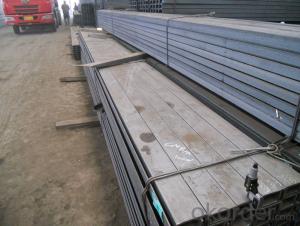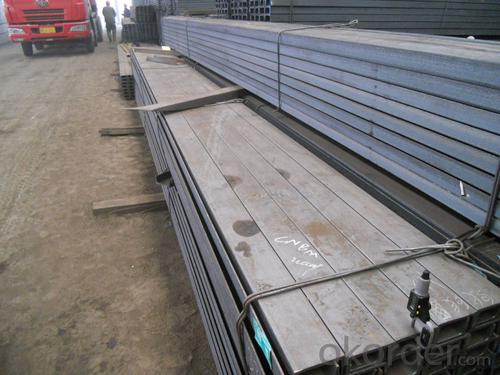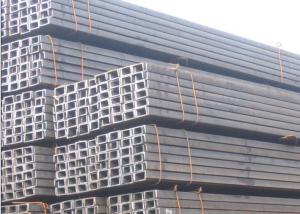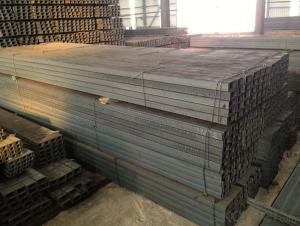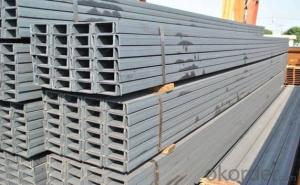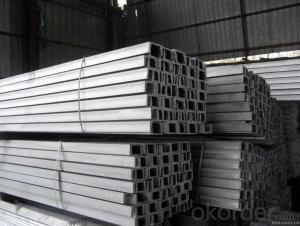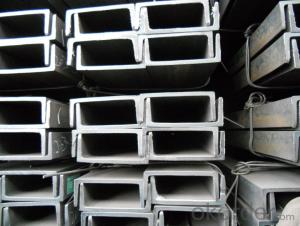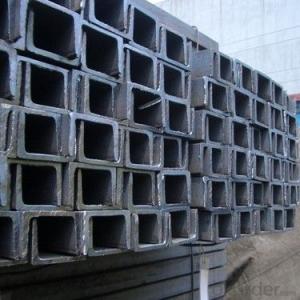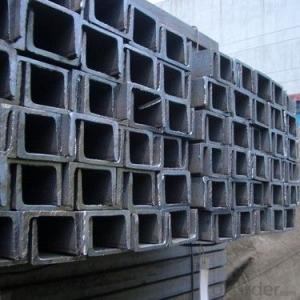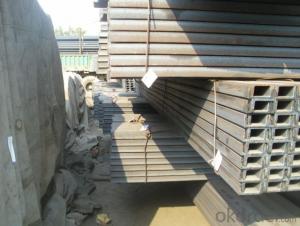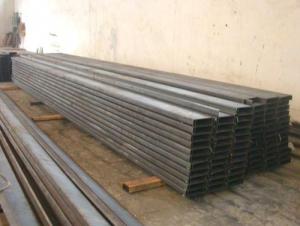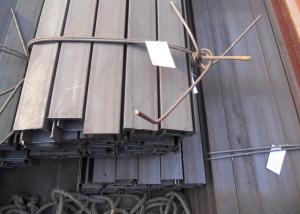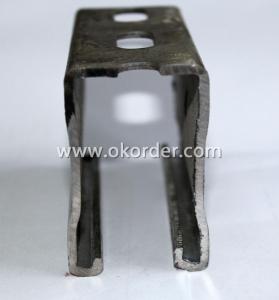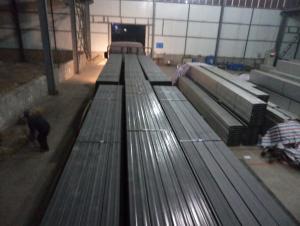JIS SS400 Steel Channel with High Quality 100mm
- Loading Port:
- Tianjin
- Payment Terms:
- TT OR LC
- Min Order Qty:
- 25 m.t
- Supply Capability:
- 10000 m.t/month
OKorder Service Pledge
OKorder Financial Service
You Might Also Like
JIS SS400 Steel Channel with High Quality 100mm
Product Description:
Standard: JIS
Material: SS400
Length: 6m, 12m
Size:
Size (mm) | Mass (Kg/m) |
100*50*3.8 | 7.30 |
100*50*5.0 | 9.36 |
Package & Delivery of JIS SS400 Steel Channel with High Quality 100mm:
1.The hot rolled channel steel will be packed in bundle with steel wire at each end of every bundle and color marking in order to help the customer to recognize his goods more easily at sight.
2. And the hot rolled channel steel could be loaded into 20ft or 40ft container, or by bulk cargo.If the weight of each bundle reaches more than 3.5 mt, the loading by break bulk cargo should be choosed.When the weight of each bundle reaches less than 3mt, the loading by container should be choosed.
3.As for the transportaion from mill to loading port, the truck will be usually used. And the maximum quantity for each truck is 40mt.
4.All in all, we could do in accordance with customer's request.
Production Flow of JIS SS400 Steel Channel with High Quality 100mm:
1.The steel billet shall be heated in the high temperature furnace.
2. The heated steel billet shall be rolled five to nine times with the aim of shaping the general figure of steel u channel.
3. The rolled steel channel should be put onto the cooling bed to make the temperature low.
4. The JIS Channel should be straighted on the straightener.
5. The straighted steel u channel will be cut into meters by saw, as per customer's requirements.
6. At the last part of production, the channel steel must be tested in order to confirm that the finished products are completely free from crack, pore, slag, scab or fold on the surface.
FAQ:
Q1: Why buy Materials & Equipment from OKorder.com?
A1: All products offered byOKorder.com are carefully selected from China's most reliable manufacturing enterprises. Through its ISO certifications, OKorder.com adheres to the highest standards and a commitment to supply chain safety and customer satisfaction.
Q2: How do we guarantee the quality of our products?
A2: We have established an advanced quality management system which conducts strict quality tests at every step, from raw materials to the final product. At the same time, we provide extensive follow-up service assurances as required.
Q3: How soon can we receive the product after purchase?
A3: Within three days of placing an order, we will arrange production. The shipping date is dependent upon the quatity, how many sizes you want and the plan of production, but is typically 1 month to 2 month days from the beginning of production.
Images of JIS SS400 Steel Channel with High Quality 100mm:


*If you would like to get our price, please inform us the size, standard/material and quantity. Thank you very much for your attention.
- Q: What are the different grades of steel used in channels?
- The specific application and requirements can cause variation in the grades of steel used in channels. Some frequently used grades are A36, A572, and A588. A36 steel, commonly utilized in construction and structural applications, is a low carbon steel. It possesses favorable weldability and machinability, making it appropriate for various channels employed in building projects. A572 steel, a high-strength, low-alloy steel, is often employed in structural applications like bridges, buildings, and machinery. It provides superior strength and toughness compared to A36 steel, rendering it suitable for heavy-duty channels requiring higher load-bearing capacity. A588 steel, also known as weathering steel, is a high-strength, low-alloy steel engineered to withstand atmospheric corrosion. It is frequently utilized in outdoor applications such as bridges, buildings, and infrastructure. A588 channels are commonly employed in coastal or severe environmental conditions where corrosion resistance is critical. Other grades of steel utilized in channels may include A992, A500, and A709, among others. Each grade possesses specific properties and characteristics, enabling its suitability for different types of channels based on intended use and environmental factors.
- Q: Is outside building protection single row bent with cantilever steel instead of channel steel?
- Construction of single door rack erection of cantilever I-beam steel can not be used instead of steel, because the provisions of article 6.10.2 JGJ130-2011 "construction of steel tubular scaffold safety technical specifications" cantilever beam application of biaxial symmetry,...... steel beams shall not be less than 160mm. Therefore, the channel shall not be used, the cross section is asymmetrical, and the cantilever bent, the cross section is more likely to be unstable.
- Q: What are the different surface finishes available for painted steel channels?
- There are several different surface finishes available for painted steel channels, each serving a specific purpose and creating a unique aesthetic appeal. Some of the most common surface finishes include: 1. Smooth finish: This is the most basic and commonly used surface finish for painted steel channels. It provides a smooth, glossy appearance, making the channels look sleek and polished. 2. Matte finish: A matte finish offers a non-reflective surface, giving the painted steel channels a more subdued and contemporary look. This finish is often preferred in applications where glare needs to be minimized. 3. Textured finish: Textured finishes add depth and dimension to the surface of painted steel channels. They can be achieved through various techniques, such as embossing or sandblasting, creating a visually interesting and tactile texture. 4. Hammered finish: A hammered finish involves creating a pattern of small indentations on the surface of the steel channels, resembling the texture of a hammered metal. This finish adds a rustic and unique appearance to the channels, making them stand out. 5. Patterned finish: Patterned finishes involve applying a specific design or pattern onto the surface of the painted steel channels. This can be achieved using various methods, such as stenciling or laser etching. Patterned finishes offer endless possibilities for customization and can be used to create intricate and eye-catching designs. 6. Metallic finish: Metallic finishes are achieved by adding metallic pigments to the paint, creating a shiny and reflective surface. This finish gives the steel channels a luxurious and high-end appearance, often used in applications where a touch of elegance is desired. It is important to note that the availability of these surface finishes may vary depending on the manufacturer or supplier of the painted steel channels. Additionally, the specific surface finish chosen may also depend on the intended use and the desired overall aesthetic of the project.
- Q: How about the Y-Y moment of inertia in the form of hot rolled channel steel Iy?
- The method of superposition of moments of inertia: the moment of inertia of multiple rectangles plus the moment of inertia of the four surfaces of the cornersEach of the deformed moments of inertia is equal to the sum of the two triangular moments of inertia and the sectorial moments of inertiaThe sectorial moment of inertia is used in integral calculus, and the examples of advanced mathematics are taken at random.
- Q: Can steel channels be used for scaffolding?
- Yes, steel channels can be used for scaffolding.
- Q: Can steel channels be used for staircases?
- Yes, steel channels can be used for staircases. Steel channels are often used as stringers, which are the structural supports for stairs. They provide strength, durability, and stability to the staircase, making them a popular choice in modern architectural designs.
- Q: Can steel channels be used in overhead crane systems?
- Yes, steel channels can be used in overhead crane systems. Steel channels provide strength and durability, making them suitable for supporting the weight of the crane and the loads it carries. They can be used as structural beams for constructing the crane runway, bridge girders, and support structures, ensuring safe and efficient operation of the overhead crane system.
- Q: Can steel channels be used as support beams?
- Steel channels, which are also referred to as C-channels or U-channels, have the ability to serve as support beams. These channels, commonly utilized in construction due to their robustness and structural stability, are specifically designed to offer support and stability, thus making them suitable for this purpose. They find widespread application in building frames, bridges, and industrial structures, where their capacity to bear loads is of utmost importance. With their high strength-to-weight ratio, durability, and resistance to bending and twisting forces, steel channels prove to be an excellent choice for effectively supporting heavy loads and evenly distributing weight. As a result, one can confidently employ steel channels as support beams in a variety of construction projects.
- Q: What are the different grades of steel channels?
- There are several different grades of steel channels, each with its own unique properties and applications. Some of the commonly used grades include: 1. A36: This is the most common grade of steel channel and is widely used in construction and structural applications. It has a minimum yield strength of 36,000 psi and is easily machinable and weldable. 2. A572: This is a high-strength, low-alloy (HSLA) steel channel grade that offers improved strength and durability compared to A36. It is often used in bridges, buildings, and other heavy-duty applications. 3. A588: This grade of steel channel is known for its corrosion resistance and is primarily used in outdoor or exposed environments. It is commonly used in construction projects where the channel will be subjected to harsh weather conditions. 4. A709: This is another HSLA steel channel grade that offers high strength and improved corrosion resistance. It is commonly used in bridge construction and other structural applications. 5. A992: This is a high-strength, low-alloy steel channel grade that is commonly used in construction and structural applications. It has a higher yield strength and tensile strength compared to A36, making it suitable for heavy-duty applications. 6. Stainless Steel: In addition to carbon steel channels, there are also stainless steel channels available in various grades such as 304 and 316. These grades offer excellent corrosion resistance and are commonly used in industries such as food processing, pharmaceuticals, and marine applications. It is important to select the appropriate grade of steel channel based on the specific requirements of the project, taking into consideration factors such as strength, corrosion resistance, and environmental conditions. Consulting with a structural engineer or steel supplier can help determine the most suitable grade for a particular application.
Send your message to us
JIS SS400 Steel Channel with High Quality 100mm
- Loading Port:
- Tianjin
- Payment Terms:
- TT OR LC
- Min Order Qty:
- 25 m.t
- Supply Capability:
- 10000 m.t/month
OKorder Service Pledge
OKorder Financial Service
Similar products
Hot products
Hot Searches
Related keywords
